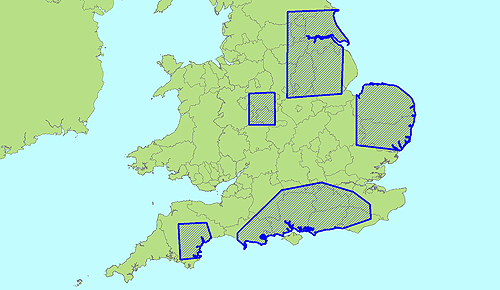National surveys for both species are currently underway, through a joint collaboration with the BTO, RSPB, Forestry Commission (England), JNCC and English Nature. The surveys are being jointly organised by BTO and RSPB.
2006 Records required
All records are still required for singing male Woodlarks (between 15th February and 31st May) and Dartford Warblers (between 1st April and 31st July). This information will be used to supplement records collected by the national surveys. Although the main sites are already being covered, we are very keen to receive details of additional records during the breeding season, particularly from potentially new sites or parts of the country where breeding records are scarce: see Maps 1 and 2. Woodlark records are especially required, as very few males were detected singing during the prolonged cold spell in early spring.
Woodlark

Woodlark: Lincs (photo: Dean Eades).
There was a five-fold increase between the last national surveys in 1986 and 1997, from 250 to 1,550 pairs. Since then, further increases have occurred where suitable habitat has become available, on heathland, within forest plantations and more recently on arable farmland. Interestingly, however, population declines are also suspected in some areas, that may not simply reflect changes in the availability of suitable breeding habitat. Instead, factors outside the breeding season may be implicated. The core areas for breeding Woodlarks are Dorset, New Forest, Thames Basin Heaths, Wealden Heaths, Breckland, Suffolk Sandlings, plus also parts of Devon, Lincolnshire, Nottinghamshire, Staffordshire and Yorkshire.
Dartford Warbler

Dartford Warbler: Suffolk (photo: Russell Hayes).
The Dartford Warbler's sedentary nature belies its ability to disperse into suitable habitats when conditions become favourable. A population of nearly 1,800 pairs was recorded in the last national survey in 1994, a fourfold increase since the previous national survey in 1984. Since the last national survey, a recent series of milder winters has encouraged further range expansion into coastal areas of East Anglia, South Wales, Exmoor, Dartmoor and Cornwall, presumably from core sites in southern England. Historically, Dartford Warblers were known to occur in parts of Oxfordshire, Hertfordshire and even Shropshire, as well as Kent. In this context, there is still plenty of ground to be reclaimed. While some of the recent range expansion is well accounted for, our picture of the more dispersed breeding population is sketchy and a more accurate assessment is required.
Have you recorded birds outside their usual range?
Maps 1 and 2 shows the areas of Core survey coverage, highlighted by the blue hatched areas bounded by a thick blue line. All records from outside these core areas are required.

Map 1. Core survey coverage for Dartford Warbler

Please send your records to Greg Conway at BTO (email: greg.conway@bto.org; tel.: 01842 750050) or Simon Wotton at RSPB (email: simon.wotton@rspb.org.uk; tel.: 01767 680551). Recording forms and further details of the surveys can be obtained from the following website:

